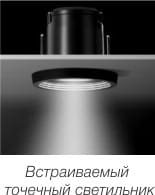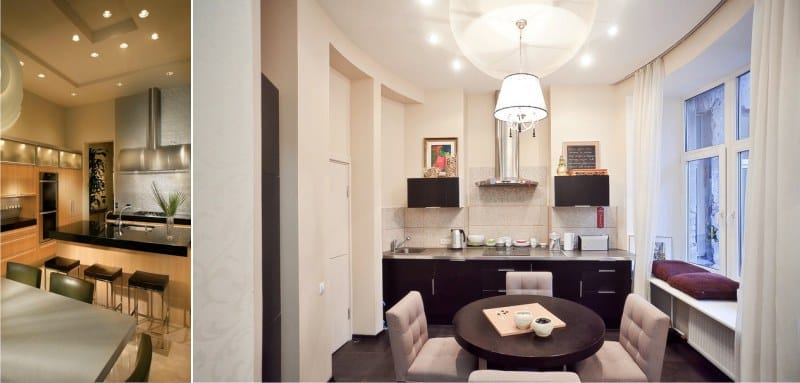Advantages and disadvantages
Spotlights can supplement or even replace the central ceiling chandelier because:
- The main advantage is that they make the lighting in the kitchen uniform, diffuse, soft, both separately and in combination with a chandelier or LED lighting. An ordinary ceiling lamp without additional lighting creates shadows and this visually narrows the space;

- The backlight on LED and halogen lamps is very economical, and the installation of spotlights with the ability to turn on in parts, that is, only where you need at the moment, for example, in the working area when you cook, significantly saves energy;
- Swivel spots and ceiling-wall lamps can direct the light wherever you want, so you can beat the advantages and disadvantages of the space - low ceilings visually lift, narrow kitchen expand combined kitchen-living room etc. How to do this will tell below;
- In addition, you can use monochrome or colored light bulbs, forming an unusual lighting design, dividing zones and placing accents.
The disadvantages of point lights include:
- More complicated compared to the chandelier installation;
- The need to think about the placement of light sources on the ceiling at the stage of repair, and the placement of spotlights built into the kitchen at the assembly stage;
- Not everyone likes this modern type of ceiling lighting in the kitchen; for some, it may resemble “office” lighting. But this is a big mistake, today spot lighting can be organically entered even into the traditional interior of the kitchen as in the photo below. The main thing - to choose the right design lighting.

Views, Facts, and Tips

- Types of spotlights for installation are divided into: mortise, overhead, suspended. If mortise can be embedded only in suspended ceilings (stretch, drywall, batten etc.), overhead (external) lamps can also be installed on a regular concrete ceiling, since there is a special mounting plate for screws on the basis of the body of such a spot;
- Embedded models are the most popular type in the category of spotlights, so they are presented in a very wide color, designer range and size range;
- Mortise lamps can be completely recessed into the base and then they are almost invisible, and can vice versa decorate the ceiling, protruding above its surface with a beautiful decorative diffuser;

- Spotlights can create local, main and decorative lighting;
- Each of the installed devices can illuminate no more than two square meters of the room;
- Modern devices are fireproof, and therefore can be used in combination with any finish.And their body is made of moisture-proof material, which makes it easy to withstand high humidity;
- There are designs with internal or external arrangement of the bulb, which provides directional or diffused light, respectively.

Tips:
- The simpler the spot design is, the easier it is to care for them — launder fatty deposits, dust, etc .;
- For suspended ceilings, it is better to choose round or corners with lamps;
- For a more economical and rational power consumption, install a dimmer, which is also called a rheostat or dimmer switch.
Types of lamps

Lamps are: LED, halogen or incandescent lamps.
LED lamps are deservedly popular. They are economical and consume very little electricity, and also practically do not heat up. Therefore, LED devices can be used in combination with very different finishes - their location, even close to flammable materials, will not cause a fire.

LED recessed lights are swivel and fixed. Rotary lamps allow you to change the direction of light.

Devices with incandescent lamps give a bright, pleasant light familiar to everyone, but they are much larger in size and therefore require installation with a large margin, in addition, they have a small service life.
From the point of view of durability and energy consumption, halogen lamps are beneficial, but they are also considered the most expensive. They provide bright, close to natural lighting, but have one drawback - the lamps are very hot, so choose a lamp with a metal frame, a glass diffuser and a ceramic cartridge.
Keep in mind that for spotlights with halogen lamps you need a transformer that converts a normal 220 watts to the required 12 watts. The power of the transformer should slightly exceed the total power of all halogen bulbs.
Installation of spotlights in the kitchen with stretch ceilings implies a limit on the power of the lamps to be installed. So, the power of halogen devices should not exceed 35 watts, and the power of incandescent lamps - 60 watts. This is due to the properties of the material, which can melt from too high temperatures.

The placement of lamps and the rules of the "game with light"
To create a basic lighting in the kitchen, ceiling spotlights should be placed at least 30-40 cm apart. From the corner of the wall, a distance of at least 20 cm is maintained. Experts advise to set one point at 1.5 square meters. m or follow the following recommendation - for every 1 sq. m of the ceiling should account for a lamp of 20 watts. If you want to install lamps with a capacity of more than 20 W or plan to combine them with a chandelier, then their number can be reduced.
Using the correct location of the spotlight, you can easily change the entire perception of space.
Visually expand a small, narrow or elongated kitchen can be, if you install a group of several lamps along the center and on both sides of the ceiling narrow or elongated kitchen. That is, the main goal is to fill the space as evenly as possible with soft, diffused light without shadows.

In the lighting of large spaces, the main task is to arrange the light sources so that they perfectly illuminate all the functional areas, but at the same time they create coziness, intimacy and a pleasant atmosphere. Most often, the lamps are arranged as in the photo below: around the perimeter of the kitchen spot, and in the center above the table or island hanging chandeliers.

The most versatile placement of spotlights in the kitchen is as follows: in the center of the kitchen, above the table or bar counter, you can hang up ceiling lights or a chandelier, and install spots only above the working area directly above the kitchen set.


But if the kitchen has low ceilings, it is better to choose a swivel model and send their light up to the ceiling, as well as install lamps on the visor of the fitted cupboards in the kitchen. Chandelier in the low kitchen is better not to hang.

In addition, spotlights allow you to perfectly zone the room, highlighting each of the functional areas. As a rule, in combined spaces - in a studio apartment, kitchen-dining room, kitchen-living room, work area, kitchen area or adjacent hallway, the spotlight is highlighted, and the seating area or dining room is lit with a chandelier and pendant lights.


Spotlights simply created to decorate and illuminate two-level ceilings. In this case, embedded models are generally used. Highlight can be all or only one level as in the next photo on the right.

How to mount spotlights correctly
Installation of spotlights requires the preparation of certain tools and devices:
- Terminals for connection;
- Flat end screwdriver;
- Crowns for wood or metal (the latter will be required to work with a slatted ceiling);
- Assembly knife for stripping wires;
- Drill;
- Nippers;
- Passatizhi;
- Stairs.
Connecting spotlights is impossible without creating the appropriate electrical wiring. At the first stage, the lighting box is installed - it is mounted in such a way that it has free access to it all the time. This means that putting the box behind the casing is not worth it. After that, a separate wire is laid from the box to each lamp. Wires must be placed in a corrugated pipe, necessary for protection.


If placement is planned in a plasterboard ceiling, then the work is carried out in the following sequence:
- The location of each device on the ceiling is accurately marked, and the location of the rails should be taken into account, the lamps should not be attached to them;
- The hole for the drill is cut to an appropriate size, and for square devices, the hole is made an electric jigsaw;
- Previously wired cable goes through the hole. Of course, during the work the wire must be de-energized. In order to surely get the cable out of the small hole, a wire hook is used;
- The wire led outside is connected in accordance with the colors through the terminals. If you use LED lights with screw clips for wires, then the terminals will not be required;
- This is followed by the location of the lamp in the hole, with the result that it is fixed with special clips-springs;
- A lamp is screwed into the device, and after that a decorative ring is put on;
- Conduct a test of the system.
- LED lights for the kitchen from A to Z
- Choosing the perfect chandelier for your kitchen
- DIY lamp for the kitchen - 3 ways and design ideas based on them
- The choice of lighting for kitchen cabinets and not only
- Sconces in the kitchen - playing with the light according to the rules



 (Rate the material! Already voted:21 average rating: 4,76 from 5)
(Rate the material! Already voted:21 average rating: 4,76 from 5)